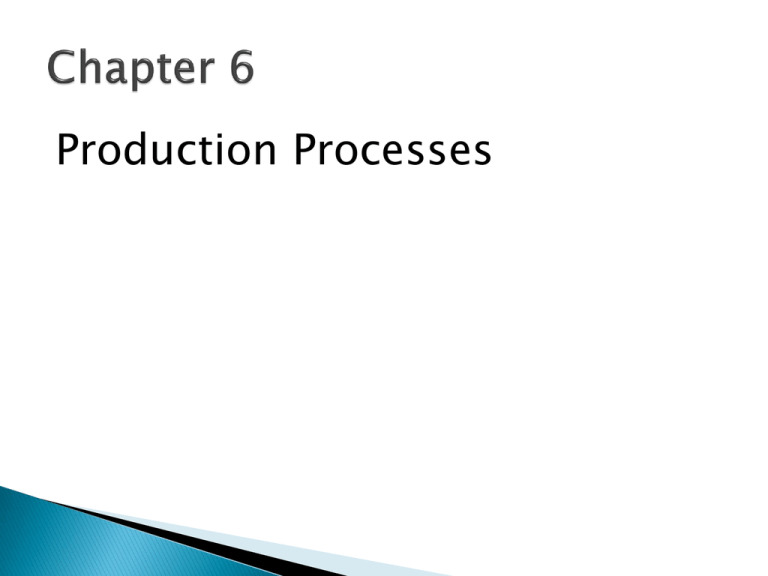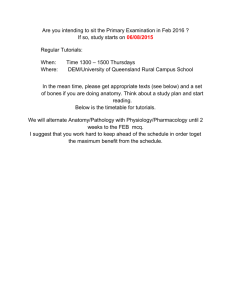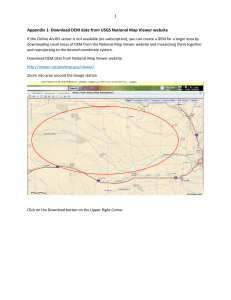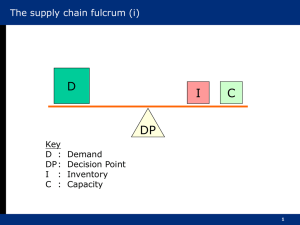PowerPoint
advertisement

Production Processes 1. 2. 3. 4. 5. Understand the idea of production process mapping. Demonstrate how production processes are organized. Explain the trade-offs that need to be considered when designing a production processes. Describe the product-process matrix. Recognize how break-even analysis is just as important in operations and supply chain management as it is in other functional areas. LO 1 Lead time: the time needed to respond to a customer order Customer order decoupling point: where inventory is positioned to allow entities in the supply chain to operate independently LO 1 Make-to-stock firms: firms that serve customers from finished goods inventory Assemble-to-order firms: firms that combine a number of preassembled modules to meet a customer’s specifications Make-to-order firms: firms that make the customer’s product from raw materials, parts, and components Engineer-to-order firm: firm that will work with the customer to design and then make the product LO 1 Examples of products ◦ Televisions ◦ Clothing ◦ Packaged food products Essential issue in satisfying customers is to balance the level of inventory against the level of customer service ◦ Easy with unlimited inventory but inventory costs money ◦ Trade-off between the costs of inventory and level of customer service must be made Use lean manufacturing to achieve higher service levels for a given inventory investment LO 1 A primary task is to define a customer’s order in terms of alternative components since these are carried in inventory ◦ An example is the way Dell Computer makes their desktop computers One capability required is a design that enables as much flexibility as possible in combining components There are significant advantages from moving the customer order decoupling point from finished goods to components LO 1 Boeing’s process for making commercial aircraft is an example Customer order decoupling point could be in either raw materials at the manufacturing site or the supplier inventory Depending on how similar the products are it might not even be possible to pre-order parts LO 1 Project: the product remains in a fixed location ◦ Manufacturing equipment is moved to the product Workcenter (job shop): similar equipment or functions are grouped together Manufacturing cell: a dedicated area where products that are similar in processing requirements are produced Assembly line: work processes are arranged according to the progressive steps by which the product is made Continuous process: assembly line only the flow is continuous such as with liquids LO 2 LO 4 A standard approach to choosing among alternative processes or equipment Model seeks to determine the point in units produced where we will start making profit on the process Model seeks to determine the point in units produced where total revenue and total cost are equal Purchasecost of processor equipment Priceper unit - Cost per unit or BreakevenDemand LO 5 T otalfixed costsof processor equipment Unit price to customer- Variable cost per unit Buy for $200 Make on lathe for $75 Make on machining center for $15 Buy has no fixed costs Lathe has $80,000 fixed costs Machining center has $200,000 fixed costs LO 5 Purchase Cost = $200 x Demand Produce Using Lathe Cost = $80,000 + $75 x Demand Produce Using Machining Center Cost = $200,000 + $15 x Demand LO 5 LO 5 P ointA $80,000 $75 Dem and $200,000 $15 Dem and $80,000 $60 Dem and $200,000 $60 Dem and $120,000 Dem and $120,000 2,000 $60 P ointB $200 Dem and $80,000 $75 Dem and $125 Dem and $80,000 LO 5 Dem and $80,000 640 $125 There are many techniques available to determine the actual layouts of the production process Each has its advantages and disadvantages LO 3 LO 3 The product remains in a fixed location A high degree of task ordering is common A project layout may be developed by arranging materials according, to their assembly priority LO 3 LO 3 Most common approach to developing this type of layout is to arrange workcenters in a way that optimizes the movement of material ◦ Optimal placement often means placing workcenters with large interdepartmental traffic adjacent to each other Sometimes is referred to as a department and is focused on a particular type of operation LO 3 LO 3 1. 2. 3. LO 3 Group parts into families that follow a common sequence of steps Identify dominant flow patterns for each part family Machines and the associated processes are physically regrouped into cells Manufacturing process flow design: A method to evaluate the specific processes that material follow as they move through the plant Focus should be on the identification of activities that can be minimized or eliminated ◦ Movement and storage ◦ The fewer the moves, delays, and storage, the better the flow LO 2 Assembly drawing: An exploded view of the product showing its component parts Assembly chart: defines how parts go together, their order of assembly and overall flow pattern Operation and route sheet: specifies operations and process routing Process flowchart: denotes what happens to the product as it progresses through the production facility LO 2 LO 2 LO 2 LO 2 LO 2











